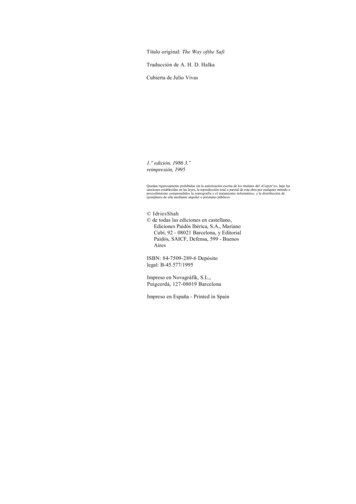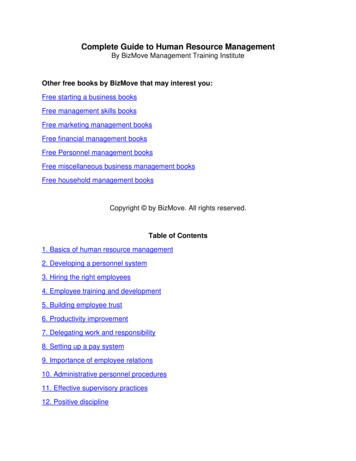
Transcription
Books by Idries ShahSufi Studies and Middle Eastern LiteratureThe SufisCaravan of DreamsThe Way of the SufiTales of the Dervishes: Teaching-stories Over a Thousand YearsSufi Thought and ActionTraditional Psychology, Teaching Encounters and NarrativesThinkers of the East: Studies in ExperientialismWisdom of the IdiotsThe Dermis ProbeLearning How to Learn: Psychology and Spirituality in the Sufi WayKnowing How to KnowThe Magic Monastery: Analogical and Action PhilosophySeeker After TruthObservationsEvenings with Idries ShahThe Commanding SelfUniversity LecturesA Perfumed Scorpion (Institute for the Study of HumanKnowledge and California University)Special Problems in the Study of Sufi Ideas (Sussex University)The Elephant in the Dark: Christianity, Islam and the Sufis(Geneva University)Neglected Aspects of Sufi Study: Beginning to Begin (The New School forSocial Research)Letters and Lectures of Idries ShahCurrent and Traditional IdeasReflectionsThe Book of the BookA Veiled Gazelle: Seeing How to SeeSpecial Illumination: The Sufi Use of HumourThe Mulla Nasrudin CorpusThe Pleasantries of the Incredible Mulla NasrudinThe Subtleties of the Inimitable Mulla NasrudinThe Exploits of the Incomparable Mulla NasrudinThe World of NasrudinTravel and ExplorationDestination MeccaStudies in Minority BeliefsThe Secret Lore of MagicOriental Magic
Selected Folktales and Their BackgroundWorld TalesA NovelKara KushSociological WorksDarkest EnglandThe Natives are RestlessThe Englishman‟s HandbookTranslated by Idries ShahThe Hundred Tales of Wisdom (Aflaki‟s Munaqib)
THE WORLD OF THESUFIAn anthology of writings about Sufis and their workIntroduction byIDRIES SHAHISF PUBLISHING
Copyright The Estate of Idries ShahThe right of the Estate of Idries Shah to be identified as the owner ofthis work has been asserted by them in accordance with the Copyright,Designs and Patents Act 1988.All rights reserved Copyright throughout the worldISBN [ENTER NUMBER HERE]First Published 1979Published in this edition 2016No part of this publication may be reproduced or transmitted in any formor by any means, electronic, mechanical or photographic, by recording orany information storage or retrieval system or method now known or tobe invented or adapted, without prior permission obtained in writingfrom the publisher, Octagon Press Ltd, except by a reviewer quoting briefpassages in a review written for inclusion in a journal, magazine,newspaper, blog or broadcast.Requests for permission to reprint, reproduce etc., to:The Permissions DepartmentISF PublishingThe Idries Shah FoundationP. O. Box 71911London NW2 9QAUnited Kingdompermissions@isf-publishing.orgIn association with The Idries Shah FoundationThe Idries Shah Foundation is a registered charity in the United KingdomCharity No. 1150876Individual Copyrights are owned as follows, and the items are reproduced herein by permissionIntroduction, Copyright 1979 by Idries ShahThe Classical Masters and Learning and Teaching 1979 by The Institute for theStudy of Human KnowledgeSanai and Sufism in the 20th Century West 1978 by David PendleburyThe Mulla Nasrudin Tales in A Naqshbandi Circle 1967 by Raoul SimacIndian Thought and Sufis 1961 by Dr. Tara ChandSpecialized Techniques in Central Asia 1962 by Ja‟far HallajiSufism and Psychiatry and Report on Mysticism 1977 by Dr. AJ. DeikmanSufi Studies Today 1968 by William FosterSufi Studies: East & West 1976 by Dr. Leonard LewinAbshar Monastery 1964 by Julian ShawThe Pointing Finger System 1968 by Sheikh Ahmed Abdullah
The Known and the Unknown in Studies 1968 by John GrantEmulation and Cycles of Study 1968 by Ali SultanLearning by Contact 1968 by Rustam Khan-UrffMeditation Method 1968 by Mir S. KhanA Sufi Organization in Britain 1961 by Arkon DaraulA Dervish Assembly in the West 1961 by Selim Brook-WhiteUse of the Five Gems 1968 by Edouard Chatelherault
CONTENTS1. IntroductionIdries Shah2. The Classical Tradition of the Sufii. The Classical MastersPeter Brentii. Sanai and Sufism in the 20th Century WestDavid Pendleburyiii. Some Sufi Tales from Burton‟s Arabian Nightsiv. In the World, not Of ItDoris Lessing3. Humour and the Sufii. In a Naqshbandi CircleRaoul Simacii. Forty-five Adventures of Mulla NasrudinHow Far to Samarkand?How to LearnThe DrunkOne Thing at a TimeLost PropertyMan of TruthThe Well and the WaterMen and WomenSnakebiteAs I ThoughtStand-inWhat Cream-Cakes Are ForThe Brain is SafeNasrudin in the Land of FoolsStraight LineLet‟s Leave it at ThatLucky It‟s MineHoneyNasrudin‟s BrotherLightHis PorterageThe WellWool and SandPoisonWhy the Mulla Never Had HalwaStorage ProblemNo Drunks
Out With the LightIn the CellarHow to Pay DebtsAccidentKnown it Long EnoughBooks and RabbitsStolen: One Rusty CoinMiraculous RemedyHot and ColdThen and NowWhat I NeedGround WheatQuantity and QualityBad EnvironmentHe Won‟t ListenPussy CatFlog HimThe Holes of Moles4. Sufism in Eastern Religioni. Indian Thought and the SufisDr. Tara Chandii. Sufi Influence on the Formation of SikhismFrederic Pincott, M.R.A.S.iii. Yoga and the SufisPundit Kishan Chand5. Therapy and the Sufii. Specialized Techniques in Central AsiaJa‟far Hallajiii. Nasrudin Looks at Mental HealthMarjory A. Bancroftiii. Sufism and PsychiatryArthur J. Deikman, M.D.iv. Report on MysticismArthur J. Deikman, M.D.6. The Practice of the Sufii. Learning and TeachingPeter Brentii. Sufi Studies TodayWilliam Fosteriii. Sufi Studies: East and WestLeonard Lewin, Ph.D.iv. Abshar Monastery
Julian Shawv. The Pointing Finger Teaching SystemAhmed Abdullahvi. The Known and Unknown in StudiesJohn Grantvii. Emulation and Cycles of StudyAli Sultanviii. Learning by ContactRustam Khan-Urffix. Meditation MethodMir S. Khanx. A Sufi Organization in BritainArkon Daraulxi. A Dervish Assembly in the WestSelim Brook-Whitexii. Use of the Five GemsEdouard Chatelherault7. Current Study Materialsi. First Principlesii. The Known as the Channel to the Unknowniii. Journey beyond Historyiv. The Regeneration and Degeneration Cycles in MysticalSufi Studyv. An Important Aspect of Sufic Studyvi. Letter from a Sufi Teacher
1. INTRODUCTIONAccording to the Sufis, human beings are ordinarily cut offfrom Objective Reality, which is the origin of everything.Human faculties, although perceptive, are limited: like aradio set which can receive only certain electromagneticwaves and not other parts of this band; all perceptionsexclude external impulses as well as receiving others.The perceived world, again according to this assertion, istherefore a distortion. The inability to transcend the barrierof limited senses explains human subjectivity: and secondaryeffects are usually perceived as primary ones.So Rumi says, in his Fihi ma Fihi: „If a sleeve moves, it isbecause the hand moved. But if the hand moves, the sleevedoes not always have to move. So if you look at the causedand do not know the causer, you imagine that the “sleeve” issomething which has a life of its own‟.*[* Professor B. Faruzanfar‟s 1952 Tehran edition of Fihi ma Fihi, Section 63 ofthe Persian text.]The Sufis further assert that they can penetrate beyond theapparent to the real in this sense, and Sufism is the methodor, rather, provides the methods, for this enterprise.They further state that theirs is a spiritual path, becausetheir experience, in their judgment, verifies that theObjective Truth, the First Cause, that which lies beyondappearances, is divine.The methods which are adopted to pierce the veil betweentruth and humankind are, accordingly, those chosen byexperienced Sufis (nobody who has not completed thisjourney can properly be called a Sufi; someone who is onlytrying is known as a seeker, a dervish, and by other names),the ones which their own overview tells them are appropriatefor the current time, place and people.This explains why so many Sufis have worked in so manyfields, and why so many Sufi schools have had so many
different conceptions of the path. Sufism is, in operation,pragmatic. Most of the supposedly Sufi organizations,exercises and „orders‟ are in fact only of archaeologicalinterest. Those who know do not need them: those who donot must find those who know, not the obsolete garments ofprevious formulations.It cannot be denied, even from an outside point of view,that someone who has been along a certain path may be ableto conduct others by that route, or find a better one: bothenterprises being more promising than a route from an oldmap which has been rendered irrelevant by a landslide.Whether acceptable by outward minds or not, the contentioncannot be faulted if the premises are conceded.If this is so, then, it may be asked, what is the use of themap which is now said to be superseded? Why collectaccounts of former enterprises and their activities?The answer is that these materials have a use other than theleading of a disciple from A to Z. Just as it would be absurdto imagine that an orange was only taste, only colour, onlyflavour or only a vehicle for seeds in its value to us, so withSufi expressions. On one of the lowest, but yet fundamental,levels, the value lies in removing misconceptions abouthumanity in human thinking and about narrowness in Sufistudies.It is easy to illustrate one of the important uses of this kindof material from an experiment carried out in the case of thepresent book.The manuscript of the work which you are now readingwas given to specialists in several fields, and to a number ofgeneral readers and metaphysicians, all of them with someinterest in Sufism and the Sufis.The results were illuminating. A psychiatrist was delightedat the psychological content but confessed himselfuncomfortable with the religious and literary material. Atheologian was distressed by the „mystical content‟ but lovedthe „spiritual beauty‟ which he found herein. An historianand orientalist was thrilled by the new information notavailable elsewhere: but at the same time annoyed that Sufistudies should have been embraced by modern workers in
the soft sciences, such as psychologists. A literary critic feltthat „the work of the great thinkers and writers in thistradition should be retained; the rest, excised‟.In other words, each wanted to regard the Sufi expressionas a part of his or her own field. Each, too, when questioned,admitted to preferring that the relevance to any other field becensored or suppressed.This reaction (for it is only one reaction in pattern, thoughapparently several because expressed variously in literary,scientific, academic and other category-terms) welldelineates the mentality of a number of typical contemporarypeople. It gives us a means of assessing them and, it is to behoped, gives them a means of noting their own limitations.And there are other contents in this material which cantake effect long before any learning in Sufism can bepromoted, but which can nevertheless pave the way for it.Happily there were other, and sufficiently wholesome,responses to the materials, which alone could justifypublication.We could have pleased every one of our specialists bysplitting the manuscripts into narrow categories, adding morematerial in the same field, and publishing each fragment as aseparate book.The list of titles would then have read, at least in part:Sufism: The Classical TraditionHumour and the SufisSufism in Eastern ReligionModern Psychology and Sufi Thought and ActionSufi Spiritual PracticesVisits to SufisThe Sufis in Literature: East and WestAnd so on. The only problem left would have been that theSufic content, value and impact would have disappeared.There was once a boy, you may recall, who dismembered abutterfly. Looking at the piles of wings, antennae, legs, headand body, he exclaimed: „There are the parts all right: butwhere has the butterfly gone?‟ This behaviour is so wellunderstood in the East that there is a term derived from thisstory „Pai-magas‟ (fly‟s-leg), to refer to perhaps interesting
but ultimately incomplete specialization.Because certain subjects have been made specializations,and because there is a habit of putting labels on things (bothadmirable tendencies if kept within proper bounds) the habitof collecting butterfly-legs has come to be accepted verywidely as equal to, or a suitable substitute for, the study ofbutterflies. Many people will deny this, talking about„fragmentation, classification and holisticism‟, but you onlyhave to talk to many of them for a time and watch theirbehaviour and methods of thought to know that, in general,these tend to be parrot-cries.In case anyone jumps to conclusions, let me say here thatthis book is not a reconstructed butterfly. It contains materialwithin a very wide range, both of subject and of competenceand relevance. As an anthology of readings it seems to me tocontain a great deal that is useful: but much will dependupon what assumptions are brought to its reading.If my own experience is anything to go by, the book willproduce as many reactions as there are types of peoplereading it. Unless carefully warned, reactions to booksinclude some very superficial behaviour. Some of the readersmight embark on journeys to the East, others might lose notime in trying out exercises, yet others are likely to use it tomanifest a desire for acceptance or rejection: to like ordislike it.I say this because I have noted that there is a tendency toemploy books to help one work out a desire already existingin the mind, regardless of the balance of the material. Asresponses to one and the same book I have found people (or,rather, they have found me) who have gone on longjourneys, rushed to look for texts mentioned in the book,tried to spread the good word, plunged into the world or fledit. I sometimes have a fantasy that I would like to put themall into a room and have them fight out which of their highlyselective interpretations is the „right‟ one.This kind of behaviour ignores, of course, the fundamentalpriority: the question as to whether the
Books by Idries Shah Sufi Studies and Middle Eastern Literature The Sufis Caravan of Dreams The Way of the Sufi Tales of the Dervishes: Teaching-stories Over a Thousand Years Sufi Thought and Action Traditional Psychology, Teaching Encounters and Narratives Thinkers of the East: Studies in Experientialism Wisdom of the Idiots The Dermis Probe Learning How to Learn: Psychology and










